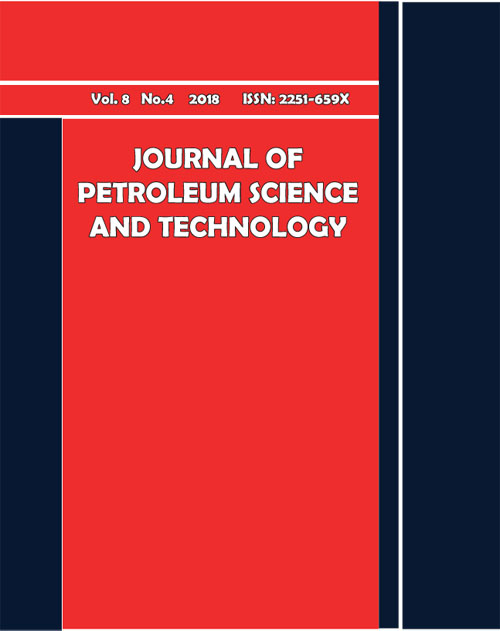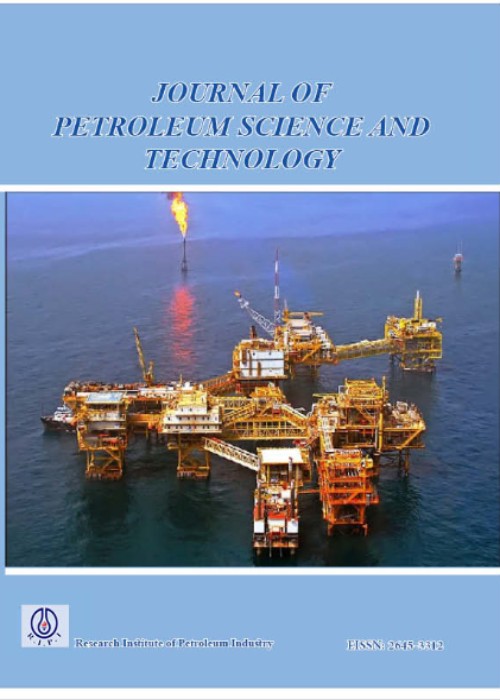فهرست مطالب

Journal of Petroleum Science and Technology
Volume:8 Issue: 4, Autumn 2018
- تاریخ انتشار: 1397/09/12
- تعداد عناوین: 6
-
-
Pages 3-15Aerogels are a special class of porous material, which have excellent physicochemical properties such as low density, high porosity, high surface area and adjustable surface chemistry. Aerogels were first prepared several decades ago, but never truly commercialized due to their high cost. Technological advancements in the production and quality of different types of aerogel cut costs down and market factors increase demand. Therefore, the viability of this porous material on the several applications has been widely studied. Among the various high-performance applications, aerogel has attracted significant attention as a chemical sorbent and catalyst for CO2 capture and conversion as well as methane conversion to value-added products. Although aerogel performance for zero CO2 emission to the environment is promising, some drawbacks of aerogels such as complicated drying process, mechanically weak structure and processing cost should also be considered in material development. Ultimately this review article will cover an overview regarding the aerogels synthesis, processing and their recent applications in CO2 capture and conversion.Keywords: Aerogel, Supercritical Drying, Catalyst, Sorbent, Carbon Capture
-
Pages 16-23Pervaporation (PV) is a well-established membrane technique used in separation; especially dehydration of organic solvents. Along with other parameters such as permeate pressure and feed temperature; feed composition is an important parameter, which affects separation characteristics and membrane performance in pervaporation. In this paper, the separation characteristics of a hydrophilic polyvinyl alcohol (PVA) membrane in the dehydration of benzene and toluene by pervaporation in the temperature range of 30-60 °C and permeate pressure of 7 mmHg have been compared. The results show that the difference in the molecular sizes of benzene and toluene and their mutual solubilities with water cause differences in separation parameters, so that for example at 50 °C, in dehydration of benzene water flux and water concentration in the permeate are 0.53 (g/hm2) and 2.03 (wt.%) respectively, while the corresponding values in toluene dehydration are 0.61 (g/hm2) and 3.19 (wt.%) respectively. Therefore these amounts result in higher pervaporation separation index (PSI) for toluene compared to benzene.Keywords: Pervaporation, Benzene, Toluene, Dehydration, Poly (vinyl alcohol)
-
Pages 24-33Hydraulic fracturing is one of the most common methods of well stimulation for reservoirs with low permeability. Hydraulic fracturing increases the flow capacity, alters flow geometry, bypasses damage and improves recovery factor. The pressure of most of Iranian oil reservoirs is declined and consequently the production is reduced. It is necessary to improve the production by using new stimulation techniques, like hydraulic fracturing. In general, hydraulic fracturing treatments are used to increase the production rate, furthermore increasing recovery factor. In such cases, the fracture length is an appropriate optimization design variable against an economic criterion, e.g., the Net Present Value (NPV). This involves the balancing of incremental future revenue against the cost of operation. The production response in economic terms shows the effect of this design parameter. In this paper, a hydraulic fracturing operation has been designed by the simulator FracCADE 5.1 then its impact on production and ultimate recovery has been investigated by ECLIPSE. According to NPV, the hydraulic fracturing schedule was designed to achieve an optimum fracture half-length.
The results show that hydraulic fracturing increases oil recovery factor and production rate significantly. According to the NPV diagram, the best fracture half-length for AZ-X well is 1100 feet and for MNS-Y well is 900 feet.Keywords: Hydraulic Fracturing, Optimum Fracture Half Length, Net Present Value, Improve Oil Recovery, Economic Criterion -
Pages 34-48Kick occurrence is a possible event during a drilling process. It is required to be handled immediately using a well control method to avoid blowout, financial losses and damages to the drilling crew. Several methods including driller, wait and weight, and concurrent are applicable in the drilling industry to control a well during a kick incident. In this study, typical well control methods were simulated for both cases of water and oil-based muds, and essential parameters such as the required time were calculated. Additionally, for each well control approach, a mathematical algorithm was proposed to simulate the process. In case of oil-based mud, the flash calculation was utilized in each depth and time by considering the effect of kick fluid dissolution in drilling mud to improve the accuracy of control parameters. Based on the results, when oil-based mud is used for drilling, extra time is required to control the well due to kick fluid dissolution in the mud and extensive changes in the mud density. In order to improve the accuracy of the calculations, critical parameters including temperature changes in the well column, dynamic drilling hydraulics, and pressure drop were considered during a well control process. In addition, the simulation of the concurrent method is one of the study innovations because of mud density alternations especially when the mud becomes heavier by a non-linear or complicated mathematical function during the process.Keywords: Well control, Two-Phase, Simulation, Water, Oil Based Muds
-
Pages 49-57The purpose of this study is the detection of lateral and vertical gradients of relative concentrations of compounds presented in oil. In addition, the detection allows us to assess potential drainage zones in a reservoir during the reservoir production by steam injection. In this paper, a new method for monitoring of steam chamber development in a 2D model was created and tested.
The methodology is used to consider the total hydrocarbon fraction. In addition, the total hydrocarbon fraction has been isolated from core extracts and has been analyzed by GCMS method (TIC) for detection of various compounds and assessment of lateral and vertical gradients of their concentration in lateral.
It has been found out that the ratio of 4- and 1-methyldibenzothiophenes (MDBT) changes in lateral and in vertical directions. These changes are caused by biodegradation of organic matter. Also laboratory research shows that 1-MDBT/4-MDBT ratio in native reservoir rocks is stable under high temperatures and pressures and this can be easily measured by GC-MS. This measurement will allow assessment of location and direction of steam chamber propagation.
In a recent work, the authors have developed a geochemical model which can be used for assessment of oil flow directions during the development of heavy oil fields by SAGD method.Keywords: SAGD Modeling, Biodegradation of Oil, Beteroatomic Compounds, Isomers, Oil-water Transition Zone -
Pages 58-75The major goal of this study is the evaluation of the source rock of Ogaden Basin using Rock-Eval Pyrolysis, Vitrinite reflectance (%Ro), and well log data of the Permo-Triassic and the Mesozoic sequences including Karro, Hamanlei, and Urandab Formations. Burial history and level of thermal maturity of the Bodle-1 well, the Calub-1 well and the Hilala-2 well were modeled based on the calibration of measured %Ro and Tmax against calculated %Ro model. The calculated Total Organic Carbon (TOC) content from the well log data compared with the measured TOC from the Rock-Eval pyrolysis in the three mentioned wells is shown to match against the shale source rock.
The total organic carbon (TOC) content value ranged from 0.48 to 4.24 wt % while the S1 and S2 values ranged from 0.05 to 0.76 (mg/g) and 8.52 to 27.88 (mg/g) respectively. Hydrogen index (HI) versus oxygen index (OI) plot has shown that the organic matter is predominately made up of type III kerogen (gas prone) while Tmax and HI indicated mixed type II/III kerogen (25% of Urandab Formation, 40% of Bokh Formation and 15% of Hamanlei and Adigrat Formations). Tmax was assessed from vitrinite reflectance (Ro) readings for Bodle-1, Calub-1 and Hilala-2 wells showed an average vitrinite reflectance values in the range of 0.5-1.4 VRo%, 0.35-1.08 VRo %, 0.55 – 0.69 VRo % respectively. The developed burial history models have revealed that Bokh Shale hydrocarbon generation has been started during lower Jurassic, and presently hydrocarbon generation has been started within the “oil window” while Urandab Shale is immature to fairly mature.Keywords: Calub, Vitrinite Reflectance, Kerogen, Bokh, Bodle


